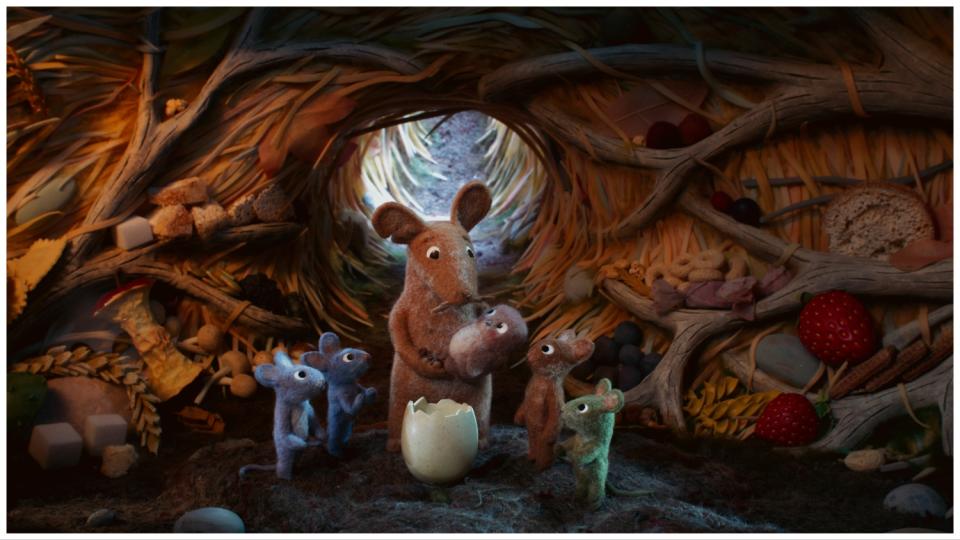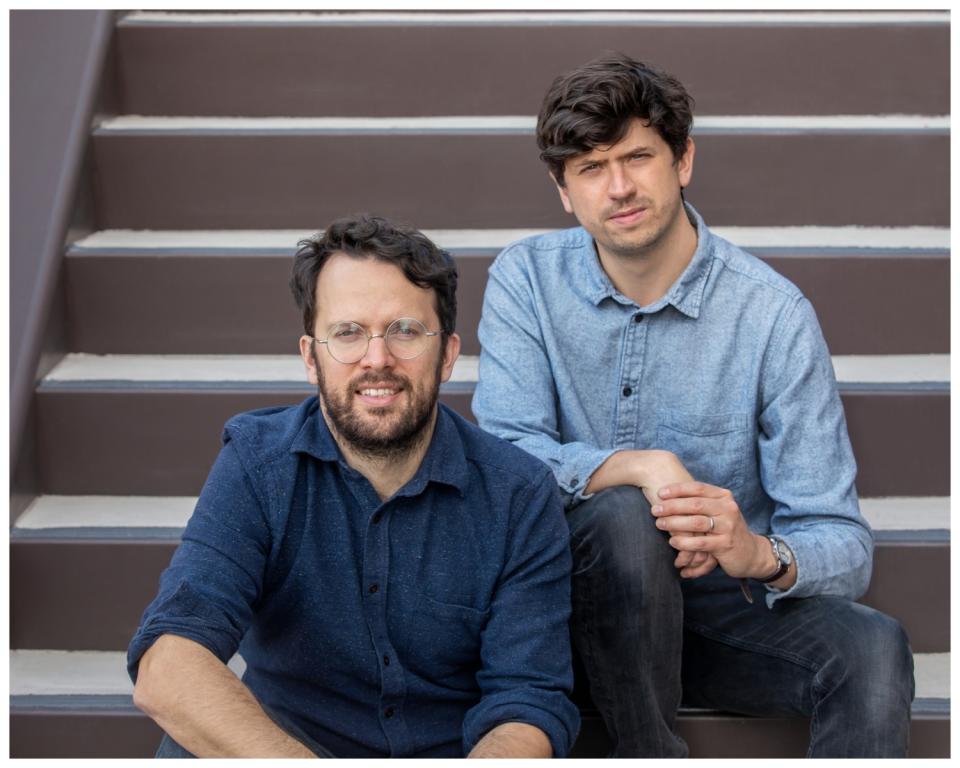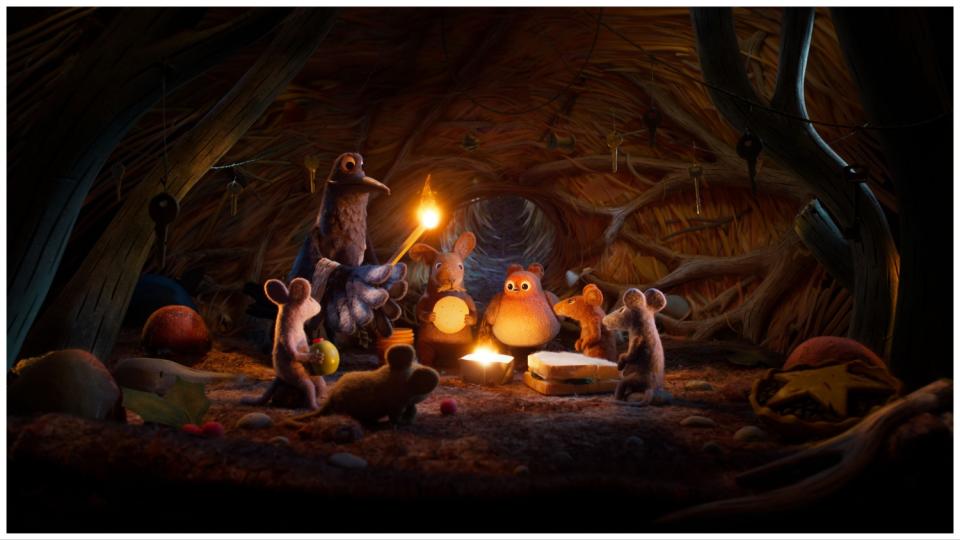Aardman Working on More Stories Set in the World of ‘Robin Robin,’ Netflix’s Oscar Nominated Musical Film (EXCLUSIVE)
- Oops!Something went wrong.Please try again later.

Dan Ojari and Mikey Please, the co-writers and co-directors of Aardman Animations’ musical film “Robin Robin,” which premiered on Netflix in November 2021, and was nominated for an Oscar the following year, say that a spinoff is in the cards.
“We are currently working on more stories in the world of ‘Robin, Robin,’” Please tells Variety. “I think that’s all we’re allowed to say. But that would certainly be our hopes and dreams. We feel like there are loads more stories to tell in this world, so we’d love to do more.”
More from Variety
“Robin Robin,” whose voice cast includes Bronte Carmichael, Adeel Akhtar, Gillian Anderson and Richard E. Grant, centers on a robin who is raised by a loving family of burglar mice. As Robin grows up, her differences become more apparent. She sets out to pull off a daring heist in a bid to prove to her family that she can be a really good mouse.
Ojari and Please are speaking to Variety at Aardman’s headquarters on Spike Island in Bristol, a city in England’s West Country, as part of a three-part series on young talent at the company. Other rising stars profiled include Matthew Walker, creator and series director of “Lloyd of the Flies,” Jane Davies, co-director and voice director on “Lloyd of the Flies,” and Lucy Izzard, creator and director of “The Very Small Creatures.”
Aardman, founded by Peter Lord and David Sproxton, is best known for the Wallace and Gromit, Shaun the Sheep and “Chicken Run” franchises. The company has won four Oscars, and earned a further nine nominations. Its latest feature film, “Chicken Run: Dawn of the Nugget,” launched on Netflix last month, and a new Wallace & Gromit film is in production, directed by Nick Park and Merlin Crossingham, with a release on Netflix set for later this year.

Ojari and Please say that the influence of Aardman was felt early on in their lives. “One thing that we both have in common is that we were raised on a staple diet of Aardman productions,” Please says. “I used to come here when I was eight to do stop-motion workshops with clay, but we both have very formative memories of seeing ‘The Wrong Trousers’ for the first time, and feeling like you’re watching magic happen. And those formative moments really stuck with us, and we both ended up making our own stop-motion films and meeting over that. So when the opportunity to come here and actually make something on a larger scale popped up it was a no brainer.”
The duo met at Wimbledon College of Art in London, where Ojari studied set design and Please majored in technical arts and special effects, but they also made animated short films while they were there. They went on to study at London’s prestigious Royal College of Art. Ojari’s 2011 graduation film “Slow Derek” traveled to more than 40 film festivals, including London and Sundance. Please’s graduation film “The Eagleman Stag” premiered at Sundance in 2011, was awarded a Special Distinction prize at Annecy Animation Film Festival, won a BAFTA, and was shortlisted for an Academy Award. His second short film, “Marilyn Myller,” premiered at Sundance in 2013, and won best short film at the British Animation Awards.
In 2014, they set up Parabella Studios in Hoxton, a shabby but chic London neighborhood, well-known as a creative hub for artists. They put in a frosted glass front door with Parabella Studios written in the style of a detective agency. Here they worked on shorts, idents and commercials. Their relaunch trailer for the 2017 season of “The Great British Bake Off” earned them a Cannes Lion Silver Award for film craft in animation. Please served as a director on Cartoon Network series “Elliott From Earth,” which premiered in 2021.
It was at Parabella that the idea for “Robin Robin” was hatched. “We had quite a lot of time to develop stuff,” Ojari explains. “We would come in some days and be like: What about this idea? And we had a sort of slate on the wall with 10 different ideas in different stages of development.” Of those, three moved forward: a comicbook, “Deadrock,” yet to be published, a TV series pilot, called “Alan the Infinite,” whose trailer can be seen here, and “Robin Robin.” “It started out just as an idea of a bird raised by some mice — a Christmas thing with a few ingredients — and then we just worked it up, mostly in one evening, into a one pager. It was like a treatment at that point,” Ojari says.
Please adds: “Over the course of three or four years, we would tell the story to people at Christmas parties again and again, to whoever would listen, and look for the moment where their eyes went dead, and they wanted to leave, and then register that that part of the story wasn’t working. So, we had a long time to — in a very relaxed way — develop the story.”
In their one pager, the pair envisioned the film as “Ugly Duckling” meets “Jungle Book” in a British countryside Christmas tale, according to Ojari. But from then on, “Ugly Duckling” was never referred to again. For Please, another story came to mind. “The parallel that I drew was ‘Pinocchio’ because it’s about someone who wants to become something that they’re not. And the thing that always bothered me about Pinocchio is that he shouldn’t change into a real boy because he is wonderful as he is.” He adds: “The reasons that I think Pinocchio was doing it was to fit in with everyone else. And in the end, he gets to fit in with everyone else and be the same as everyone else, but I always felt like he was way better as a puppet.”

While they developed the project, the pair anxiously kept watch in case a similar project appeared on the scene. Ojari says: “Every year I would hold my breath, thinking: Is there going to be something about a robin? Because I just felt like even just a robin-based Christmas special would be enough for people to go: ‘Oh, it’s a bit like that.’ And there was an advert for [department store] Marks and Spencer that was about a robin, and I was like: ‘Argh!'”
The project survived, but they didn’t pitch it in a formal way for a few years until they met Sarah Cox, the head of development at Aardman, at Annecy in June 2019. Even then the pitch was delivered in an ad hoc way in a crowded canteen. By that point, they had the treatment, a script, a storybook, with illustrations by Briony May Smith, and the lyrics for the songs, which were being put to music by Ben Please and Beth Porter of The Bookshop Band. In the bustling canteen in Annecy, they went through the picture book with Cox, and sang one of the songs — in the voice of the mischievous character Magpie — to her. Shortly after, with Aardman on board, they pitched it to Netflix, and started production in January.
Ojari says one element of the story is the contrast between the wild, dramatic lives of the animals and birds and the domesticated human world. “It’s that contrast of them looking for crumbs and having these big adventures while we [humans] are completely unaware,” Ojari says.

The humans are seen as slightly threatening figures in the film. “For a mouse going into a human house it’s a ‘Jack and the Beanstalk’ situation, filled with these giant, otherworldly figures, and the mice have to somehow sneak under the radar,” Please says.
Robin and her mouse family have to enter the human world to find food, and the spirit in which this is done evokes another fictional character: Robin Hood. But the creators describe the actions of the family as not stealing but “sneaking.” Please explains: “Sneaking feeds well into [Robin’s] central problem, which is that she is not very sneaky. She is a loud rambunctious bird in a family of more delicate, sneaky mice.”
There’s a slapstick quality to the film, provided by the clumsy Robin. Please says: “The physical comedy was a very important aspect of it, and particularly Robin’s character. A lot of her frenetic, scatty energy came from Bronte Carmichael, who was the voice performer for Robin. She had this really wonderful take on Robin, which was quite scatty. She couldn’t keep her head still for more than two seconds, and had a bumbling delivery.”
Ojari adds that some of the slapstick elements came from improvisations provided by the story-board artists and these would be incorporated into the scripts as the project progressed. The same was true of the animators in the testing phase, Please says. “You’d ask: Can you just test out a little walk cycle or a little dance, particularly the sequence with the mice on the top of the fence posts. And they would come back with something just delightfully surprising, that you weren’t expecting but were so rich that we’d have to find a way to squeeze those little moments into the show.”
It may be assumed that those working at Aardman are expected to follow the company’s aesthetic, but even with the choice of materials for puppets Ojari and Please felt no pressure to conform to the use of clay, and opted instead for needle-felt, giving the creatures a woolly feel. “Early on — before we had devised the needle-felt look — there were conversations about using the Aardman aesthetic of clay and go down that route. But we were excited to just have a go at trying something different,” Please says.
Ojari adds: “There was a big appetite here [for us to do something different] as well. I had assumed that [there would be pressure to adopt the company’s aesthetic]. Aardman has got a very distinctive and well-known style. But the culture here and where [the company] came from, is really explorative, creator led. Odd projects that grow into bigger things. And what is really great about being here is that culture of supporting creators with a character they’ve made or a story and trying to grow it into something for a wider audience, for a family audience. And Netflix as well were really keen just to support the creators and the creative vision behind the project and go all in on that, which was wonderful.”
Please says: “But I think also, luckily, there were lots of natural alignments between the project that we’d been developing and what is an Aardman production, which isn’t anything to do with clay, but to do with underdog characters, weirdos and certain things on the fringe.”
Ojari observes that the film was infused with the personality of the wider Aardman staff because of the influence of the crew who worked on the project. “You’re not really conscious of it at the time because it’s such a task to put a film together, but afterwards, you sit back and say ‘Yeah, it has been infused with that humor that the wonderful people we work with have been refining for years.'”
Best of Variety
Sign up for Variety’s Newsletter. For the latest news, follow us on Facebook, Twitter, and Instagram.

